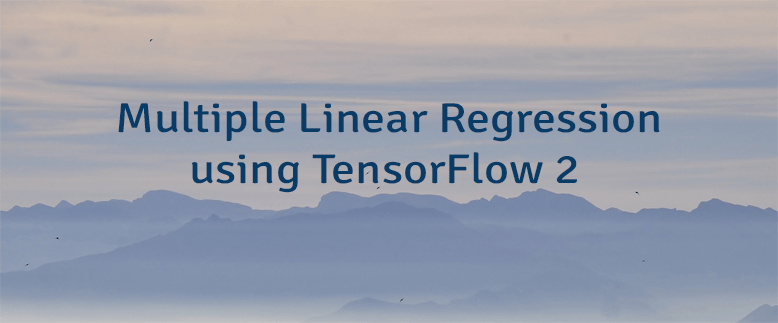Multiple linear regression (MLR) is a statistical method that uses two or more independent variables to predict the value of a dependent variable. MLR is like a simple linear regression, but it uses multiple independent variables instead of one.
| Regression | Independent variables | Dependent variables |
|---|---|---|
| Simple linear regression | 1 | 1 |
| Multiple linear regression | >= 2 | 1 |
Let's say we have three independent variables x1, x2 and x3 and dependent variable y:
| x1 | -2 | -1 | 0 | 1 | 2 | 3 | 4 |
| x2 | 1 | 2 | 3 | 4 | 5 | 6 | 7 |
| x3 | -5 | -4 | -3 | -2 | -1 | 0 | 1 |
| y | -6 | 0 | 6 | 12 | 18 | 24 | 30 |
Relationship between these variables are represented by formula y = 2 * x1 + 3 * x2 + x3.
This tutorial provides an example how to create and train a model which predicts the value of y for the given values of x1, x2 and x3. We will use TensorFlow 2.
Using pip package manager, install tensorflow from the command line.
pip install tensorflowIn order to train the model, we declare arrays - x1s, x2s, x3s and y. Inputs for the model should be presented in the single array. So we use the stack method to join x1s, x2s and x3s arrays along a new axis.
Model has one layer with three inputs and one output. Model is compiled using MSE loss function and SGD optimizer. We use 400 epochs to train the model.
from tensorflow import keras
import numpy as np
x1s = np.array([-2.0, -1.0, 0.0, 1.0, 2.0, 3.0, 4.0], dtype=float)
x2s = np.array([1.0, 2.0, 3.0, 4.0, 5.0, 6.0, 7.0], dtype=float)
x3s = np.array([-5.0, -4.0, -3.0, -2.0, -1.0, 0.0, 1.0], dtype=float)
x123s = np.stack((x1s, x2s, x3s), 1)
ys = np.array([-6.0, 0.0, 6.0, 12.0, 18.0, 24.0, 30.0], dtype=float)
model = keras.Sequential([
keras.layers.Dense(units=1, input_shape=[3])
])
model.compile(optimizer='sgd', loss='mean_squared_error')
model.fit(x123s, ys, epochs=400)
x1 = 16.0
x2 = 19.0
x3 = 12.0
x123 = [x1, x2, x3]
y = model.predict([x123])
print(y[0])After training, we predict the value of y for the given values of x1, x2 and x3. Model returns that y is 100.96393. We can verify by calculating:
y = 2 * x1 + 3 * x2 + x3 = 2 * 16 + 3 * 19 + 12 = 101



Leave a Comment
Cancel reply